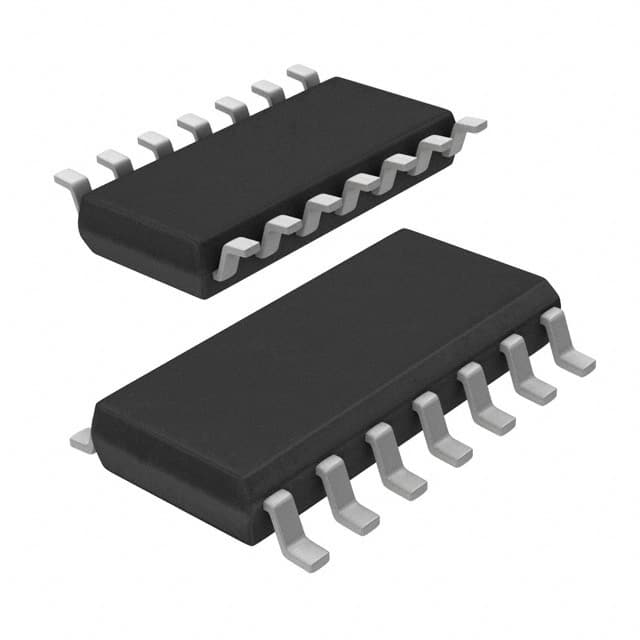Encyclopedia Entry: 74ALVC14D,112
Product Information Overview
- Category: Integrated Circuit (IC)
- Use: Logic Gate Inverter
- Characteristics: High-speed, low-power, Schmitt-trigger input, wide operating voltage range
- Package: SOIC-14
- Essence: Hex Schmitt-trigger inverter
- Packaging/Quantity: Tape and Reel, 2500 units per reel
Specifications
- Supply Voltage Range: 1.65V to 5.5V
- Input Voltage Range: -0.5V to VCC + 0.5V
- Output Voltage Range: 0V to VCC
- Operating Temperature Range: -40°C to +85°C
- Propagation Delay: 2.3ns (typical) at 3.3V supply voltage
Detailed Pin Configuration
The 74ALVC14D,112 IC has a total of 14 pins arranged as follows:
__ __
Y1 | 1 14 | VCC
A1 | 2 13 | Y6
B1 | 3 12 | A6
A2 | 4 11 | B6
B2 | 5 10 | A3
Y2 | 6 9 | B3
GND | 7 8 | Y3
--------
Functional Features
- Hex Schmitt-trigger inverters with high noise immunity
- Wide operating voltage range allows compatibility with various systems
- Low power consumption makes it suitable for battery-powered devices
- Schmitt-trigger inputs provide hysteresis, ensuring stable output even in the presence of noise or signal distortion
Advantages and Disadvantages
Advantages: - High-speed operation enables efficient signal processing - Low power consumption extends battery life in portable devices - Schmitt-trigger inputs enhance noise immunity and signal integrity - Wide operating voltage range allows for versatile applications
Disadvantages: - Limited number of inverters (6) in a single package - Not suitable for high-power applications due to low output current capability
Working Principles
The 74ALVC14D,112 is a hex Schmitt-trigger inverter IC. It operates by taking an input signal and producing the logical complement of that signal at the output. The Schmitt-trigger inputs ensure that the output transitions occur at different voltage levels for rising and falling input signals, providing hysteresis and improving noise immunity.
Detailed Application Field Plans
The 74ALVC14D,112 finds applications in various fields, including:
- Digital Communication Systems: Used for signal conditioning and level shifting in data transmission circuits.
- Automotive Electronics: Employed in automotive control systems, such as engine management, ABS, and airbag systems.
- Consumer Electronics: Integrated into audio/video equipment, gaming consoles, and home automation systems for signal processing and logic functions.
- Industrial Automation: Utilized in PLCs (Programmable Logic Controllers), motor control units, and sensor interfaces.
- Medical Devices: Incorporated into medical instruments and monitoring systems for signal conditioning and amplification.
Detailed and Complete Alternative Models
Some alternative models to the 74ALVC14D,112 include:
- SN74LVC14A - Hex Schmitt-trigger Inverter, SOIC-14 package
- CD40106B - Hex Schmitt-trigger Inverter, DIP-14 package
- MC74VHC1G14 - Single Schmitt-trigger Inverter, SOT-23 package
- 74HC14 - Hex Inverter with Schmitt-trigger Inputs, SOIC-14 package
These alternative models offer similar functionality and can be used as substitutes depending on specific requirements.
Word count: 324 words
Senaraikan 10 soalan dan jawapan biasa yang berkaitan dengan aplikasi 74ALVC14D,112 dalam penyelesaian teknikal
Sure! Here are 10 common questions and answers related to the application of 74ALVC14D,112 in technical solutions:
1. What is the function of the 74ALVC14D,112? The 74ALVC14D,112 is a hex inverter with Schmitt-trigger inputs. It converts low-level signals to high-level signals and vice versa.
2. What is the operating voltage range for the 74ALVC14D,112? The 74ALVC14D,112 operates within a voltage range of 1.65V to 3.6V.
3. Can the 74ALVC14D,112 be used in both digital and analog applications? No, the 74ALVC14D,112 is primarily designed for digital applications and is not recommended for use in analog circuits.
4. How many inverters are there in the 74ALVC14D,112 package? The 74ALVC14D,112 contains six independent inverters.
5. What is the maximum output current that can be sourced or sunk by each inverter? Each inverter in the 74ALVC14D,112 can source or sink up to 24mA of current.
6. Can the 74ALVC14D,112 tolerate 5V input signals? No, the 74ALVC14D,112 is not 5V tolerant. It is designed to operate at lower voltages and may get damaged if exposed to 5V input signals.
7. Is the 74ALVC14D,112 suitable for high-speed applications? Yes, the 74ALVC14D,112 is designed for high-speed operation and has a propagation delay of typically 3.8ns.
8. Can the 74ALVC14D,112 be used in battery-powered applications? Yes, the 74ALVC14D,112 is suitable for battery-powered applications as it operates within a low voltage range and has low power consumption.
9. What is the temperature range in which the 74ALVC14D,112 can operate? The 74ALVC14D,112 can operate within a temperature range of -40°C to +85°C.
10. Can the 74ALVC14D,112 be used in automotive applications? Yes, the 74ALVC14D,112 is AEC-Q100 qualified, making it suitable for automotive applications where reliability and performance are crucial.
Please note that these answers are general and may vary depending on the specific datasheet and manufacturer's recommendations for the 74ALVC14D,112.


